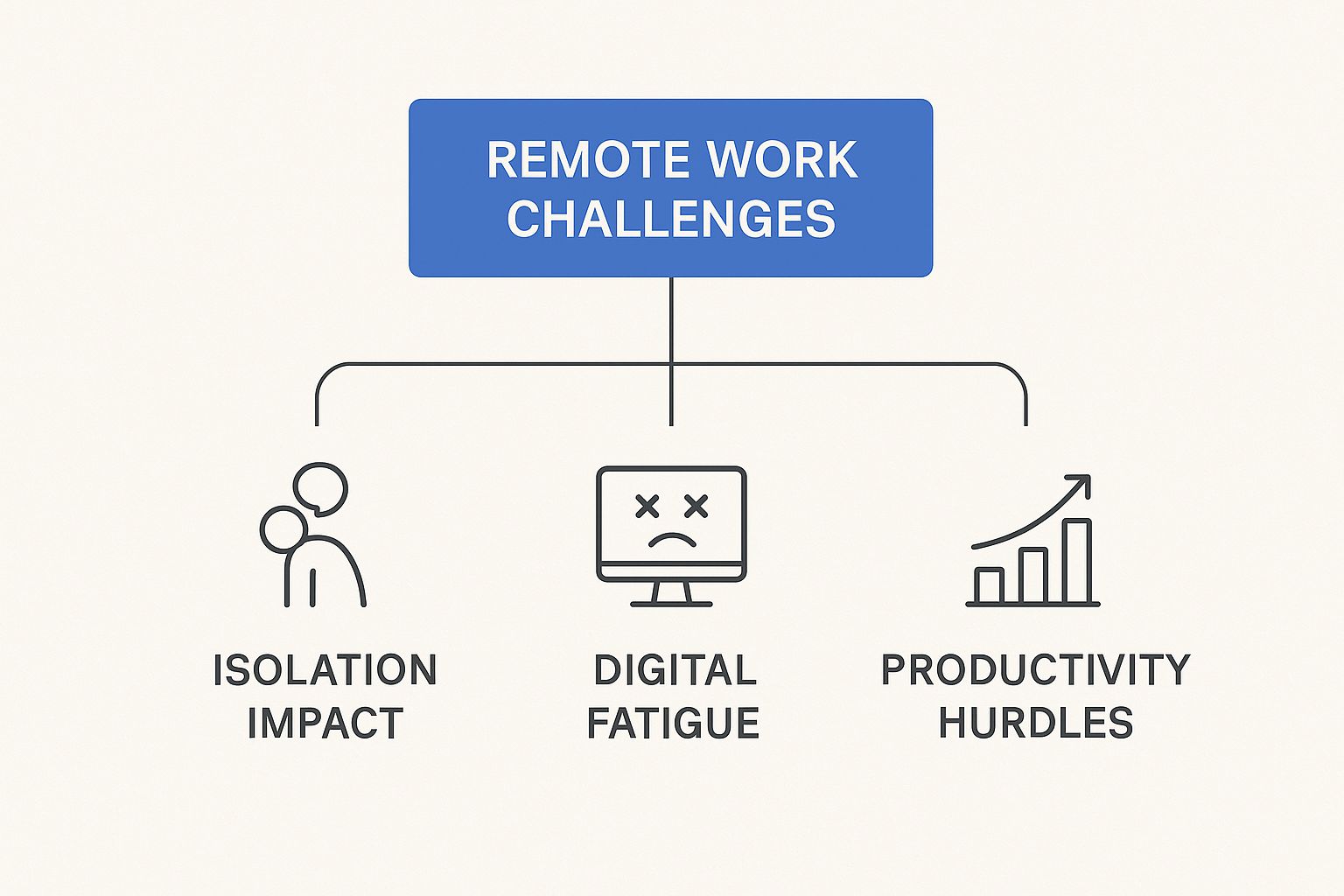Mastering the Challenges of Working Remotely

When you peel back the layers of remote work, you often find the same three culprits at the heart of most struggles: isolation, digital fatigue, and the constant battle to maintain productivity. The very freedom of being outside a traditional office can leave professionals feeling lonely, drained by endless video calls, and unable to draw a clear line between work and home.
The Shifting Landscape of Remote Work
The global move toward remote work was framed as a ticket to ultimate flexibility, but the reality is far more complex than just having a slow Wi-Fi connection. While the perks are undeniable, the day-to-day can feel like navigating a minefield of subtle but powerful obstacles. These aren't just small annoyances; they're persistent problems that can seriously affect mental health, team dynamics, and how much you actually enjoy your job.
Getting a handle on these pain points is the first, most crucial step. So many of us were thrown into remote work without a playbook, unprepared for the mental toll of working alone or the constant hum of digital noise from notifications and back-to-back meetings. The very tools designed to keep us connected can easily become the biggest sources of our stress.
Common Remote Work Hurdles
Let's break down the most common issues people face when working from home. They usually fall into a few key categories.
- The Psychological Toll: This covers everything from the gnawing feeling of loneliness and feeling disconnected from your team to the anxiety that builds when your work life bleeds into your personal time.
- Communication Breakdowns: Without face-to-face interaction, it's easy for misunderstandings to pop up. You lose all those non-verbal cues, and important information gets trapped in silos because those spontaneous "water cooler" chats just don't happen.
- Productivity and Focus Puzzles: Your home is full of distractions, from laundry to family, and the pressure to be "always on" can make it impossible to truly switch off. This is a fast track to both lower-quality work and complete burnout.
This infographic does a great job of showing how these challenges all stem from the core of working remotely.

As you can see, things like isolation, digital fatigue, and productivity slumps are all tangled together. One problem often feeds another, creating a cycle that feels impossible to escape without a clear plan.
Building a successful and sustainable remote career means being intentional. You have to create the systems and boundaries that an office once provided for you. For a deep dive into creating those systems, check out our guide on remote work best practices for some great, actionable tips.
Core Remote Work Challenges and Their Solutions
To help you get started, here's a quick overview of the primary challenges discussed in this guide and a core strategy for each. Think of this as your immediate, actionable framework.
| Challenge | Core Solution |
|---|---|
| Isolation and Loneliness | Proactively schedule non-work-related social interactions, both virtual and in-person, to build connections. |
| Digital Fatigue | Implement "communication-free" blocks in your schedule and advocate for asynchronous communication. |
| Productivity and Focus | Design a dedicated workspace and establish a firm "end of day" ritual to separate work from personal life. |
By recognizing these hurdles and applying targeted solutions, you can start to regain control and build a remote work life that's not just productive, but genuinely fulfilling.
Winning the Battle Against Digital Burnout
That never-ending flood of notifications, the wall of back-to-back video calls, the unspoken pressure to always be online… sound familiar? It’s a fast track to digital exhaustion, a unique kind of burnout that’s become one of the most common hurdles in remote work. This isn't just about being tired; it's a specific fatigue fueled by the very tools that enable us to work from anywhere.

You’ve probably heard it called "Zoom fatigue," but it’s more than just being sick of meetings. It’s a genuine cognitive problem. When we talk to someone in person, our brains effortlessly process a rich tapestry of non-verbal cues—body language, eye contact, the simple sense of presence. Video calls flatten that experience, stripping away most of those signals and forcing our brains to work overtime just to fill in the gaps.
The result is a much higher mental load. We're constantly "on," performing for the camera, staring intently at a grid of faces, and straining to catch social cues that are normally second nature. This hyper-vigilant state is exhausting and simply not sustainable long-term.
Reclaiming Your Energy and Focus
Beating digital burnout isn't about working less; it’s about working smarter. It means getting intentional about creating boundaries and actively managing your digital world to reduce that cognitive strain. The whole point is to build routines that protect your mental energy and carve out space for deep, uninterrupted work.
A great first step is scheduling structured breaks for your mind and your eyes. This can be as simple as blocking out "no-meeting" time on your calendar. Some teams even institute a company-wide "No-Meeting Friday" to give everyone a chance to catch up and decompress.
Another deceptively simple trick is the 20-20-20 rule, which directly targets the digital eye strain that contributes so heavily to feeling drained.
- Every 20 minutes, step away from your screen.
- Find an object about 20 feet away.
- Focus on that object for at least 20 seconds.
It’s a tiny action that lets your eye muscles relax and gives your brain a much-needed reset. Think of it as a micro-habit with a macro impact on your daily well-being.
Shifting Your Communication Culture
Let's be honest: the relentless demand for video calls is a huge part of the problem. A recent survey highlights the scale of screen fatigue, with three out of four employees reporting they experience it. On top of that, about 45% say they feel drained often or always because of the intense focus virtual meetings require. You can dive into more remote work statistics to see the full picture.
The most effective way to fight this is to make a cultural shift toward asynchronous communication. Not every discussion needs to happen in a real-time meeting.
By leaning on detailed emails, clear updates in a project management tool, or even quick recorded video messages, teams can dramatically cut down on live calls. This approach respects everyone's focus time and allows people to contribute when they're truly ready, not just because a calendar invite popped up.
Ultimately, winning the battle against digital burnout comes down to creating a culture where logging off is not just accepted, but celebrated. When a team actively works to protect its collective focus, it builds a remote environment that's not only more sustainable but far more effective.
Building a Strong Virtual Communication Culture
When you work in an office, so much communication is accidental, in the best way possible. You solve a problem waiting for the coffee to brew, you clarify a project detail walking back from lunch, and you get a feel for the team's mood just by being in the same room.
Remote work strips all of that away. Suddenly, every single interaction has to be intentional. This is easily one of the biggest hurdles to clear when you go remote, and if you don't get it right, you'll find yourself dealing with constant misunderstandings and knowledge getting trapped in little pockets of your team.

We've all been there. A short Slack message, sent in the name of efficiency, lands like a ton of bricks—coming off as abrupt or even rude. Without the context of a smile or a gesture, a lot gets lost in translation. It’s also incredibly easy for crucial information to stay locked in a specific chat channel, leaving the rest of the team completely in the dark. That kind of friction doesn't just feel bad; it grinds progress to a halt.
The answer isn't just to schedule more meetings or send more messages. It's about being deliberate and creating a playbook for how your team actually talks to each other.
Choosing the Right Tool for the Job
One of the most common mistakes I see is teams using every communication tool for everything. It's like trying to use a hammer for a screw—it just doesn't work. Before you know it, critical project updates are buried under a mountain of GIFs in a chat channel, while urgent questions die a slow death in an email inbox.
A healthy virtual culture starts with having clear guidelines for what tool to use, and when.
Think about it this way:
- Instant Messaging (Slack, Teams): This is your digital "tap on the shoulder." It’s perfect for quick questions, fast updates, and informal chatter that doesn’t need to be saved forever.
- Project Management (Asana, Trello): This is your team's single source of truth. All official communication about tasks, deadlines, and responsibilities lives here. It creates clarity and keeps everyone accountable.
- Video Calls (Zoom, Google Meet): Save these for the important stuff. Use them for complex problem-solving, giving sensitive feedback, or team-building moments where seeing faces and hearing tone is non-negotiable.
When you create this kind of clarity, you cut through the noise and make sure every message is heard in the right context.
Championing Asynchronous Workflows
The real secret to great remote communication is leaning into an asynchronous-first mindset. This means your default way of communicating doesn't demand an instant reply from everyone. It's a game-changer because it gives your team the space they need for deep, focused work without constant interruptions.
Communication gaps are a huge pain point in remote work. Research shows that 30-40% of remote workers feel less connected to their colleagues than they did in an office. Building an async-first culture is a direct and powerful way to bridge that gap while actually boosting productivity.
For this to work, you have to set some ground rules as a team. Agree on what a "reasonable" response time is for different channels. Maybe it’s 24 hours for an email, but a few hours for a tag in your project management tool. This simple step manages expectations and helps kill the "always-on" culture that leads to burnout. By intentionally designing these communication systems, you can sidestep the biggest pitfalls of remote work. To see what software can make this happen, check out some of the best remote team collaboration tools on the market.
4. Fostering Connection and Conquering Isolation
One of the toughest hurdles in remote work has nothing to do with Wi-Fi speeds or project management software. It’s about something far more fundamental: the human need to connect with other people.
Your home office can start to feel like a deserted island. Without the casual chats by the coffee machine or the quick questions over a cubicle wall, a subtle but powerful sense of isolation can creep in. Before you know it, it's chipping away at morale and fraying the threads that hold a team together.
This isn't just about missing watercooler gossip. When that feeling of disconnection takes hold, motivation can plummet, creative sparks fizzle out, and you can start to feel more like a name in a Slack channel than a valued member of the team. Fighting this requires a deliberate, proactive effort to build a real community, even when you’re miles apart.
Intentionally Building a Virtual Community
You can't just sit back and hope a strong team culture will magically appear in a remote setup. It won't. You have to build it, piece by piece, with intentional moments for genuine, non-work-related interaction. The goal is to recreate the spirit of the breakroom or the casual post-meeting chat, just in a digital space.
Even simple, structured activities can have a massive impact:
- Virtual Coffee Breaks: Put a 15-minute optional video call on the calendar. No agenda, no work talk—just a chance to catch up and chat like you would in an office kitchen. It's a low-pressure way to connect on a human level.
- Dedicated "Fun" Channels: Create specific channels in your team chat for things like hobbies, pets, music, or sharing weekend photos. These spaces invite the kind of lighthearted banter that forges real relationships.
- Online Team-Building: Plan a virtual team event using online games or other shared activities. Shifting the focus from deadlines to having fun together is an incredible way to strengthen bonds.
The point isn't to force friendships. It's to create the fertile ground where they can grow naturally. When you offer different ways for people to connect, you let them build relationships in a way that feels authentic to them.
The Manager’s Role in Fighting Loneliness
While everyone on the team can contribute, managers are on the front lines in the battle against isolation. Regular one-on-one meetings are your best tool, but they have to be more than just a rundown of project statuses and to-do lists.
A great manager’s check-in is about the whole person. You need to ask direct, caring questions like, "How are you really doing with your workload?" or "Is there anything I can do to make your week better?" This simple act shows you see them as a human being, not just a cog in the machine.
That consistent, personal attention is the most powerful antidote to the loneliness many remote workers face. It’s what turns a disconnected remote job into a supportive and engaging career.
Creating Boundaries for Productivity and Balance
When your commute is just a ten-step shuffle from your bed to your desk, the lines between “work time” and “home time” can get dangerously blurry. Before you know it, you're living in a single, never-ending day. This slow erosion of boundaries is one of the sneakiest—and most draining—challenges of remote work.
Without the clear physical separation of an office, the workday has a tendency to creep into personal hours. This inevitably leads to distractions, a drop in productivity, and eventually, full-blown burnout.

The amazing freedom of working from home comes with the non-negotiable responsibility of managing yourself. A traditional office provides built-in structure. At home, you’re the architect. It's on you to build that structure from the ground up, creating both a physical and mental divide to protect your focus and your sanity.
It all comes down to consciously designing a space and a schedule that tells your brain when it’s time to work and—just as importantly—when it’s time to stop.
Mastering Your Time and Space
Getting a handle on your time is your first line of defense against the workday spilling over into your evening. Instead of letting your day be a reactive mess of incoming emails and notifications, you can take back control with a couple of proven frameworks.
Two of my go-to methods are:
- The Pomodoro Technique: This is a classic for a reason. You work in focused 25-minute sprints, then take a short break. It’s brilliant for breaking down intimidatingly large tasks and keeping your brain from turning to mush.
- Time-Blocking: With this approach, you schedule every part of your day—from deep work sessions to your lunch break and even small admin tasks. By giving every activity a specific time slot, you stop guessing what to do next and are way less likely to get pulled off track.
Building these habits is about more than just checking items off a to-do list; it's about reclaiming ownership of your day. You're creating an intentional structure that prevents the chaos of home life from derailing your professional focus.
Beyond taming your schedule, managing your physical space is critical. If you can, set aside a specific room or even just a corner of your home exclusively for work. This spatial separation sends a powerful psychological signal to your brain. It makes it much easier to slip into "work mode" when you sit down and, crucially, to switch off when you walk away. For a deeper dive, we have more guides covering work-life balance strategies.
The Power of Daily Rituals
Just as important as where you work are the rituals that bookend your day. Think of them as the mental "on" and "off" switches that your old commute used to provide.
A solid start-of-day ritual might look like getting dressed in real clothes (not pajamas!), making coffee, and reviewing your top priorities for the day before you even think about opening your inbox. This simple routine primes your brain for a productive session.
An end-of-day ritual is your secret weapon for disconnecting. It could be as simple as closing your laptop and putting it away, tidying your desk for the next morning, or going for a short walk to clear your head. This final act of closure tells your brain the workday is officially over, allowing you to be fully present in your personal life.
By combining these physical and mental boundaries, you can conquer one of the most persistent challenges of working remotely and build a career that's both sustainable and balanced.
Your Top Remote Work Questions, Answered
As we've dug into the big topics like burnout and staying connected, you probably have some specific questions bubbling up. That's completely normal. Making remote work really work often comes down to solving the little day-to-day puzzles.
This section is all about getting straight to the point. Think of it as a cheat sheet for the most common hurdles people face when they're no longer commuting to an office.
How Do I Actually Separate Work and Home Life When They're in the Same Place?
This is probably the single most important skill to master for long-term remote success. When your office is ten steps from your bed, the lines get blurry fast. You have to intentionally create the boundaries that a physical commute used to handle for you.
Start with a dedicated workspace. It doesn't have to be a separate room with a door; even a specific corner of the kitchen table or a small desk in the living room works. The key is creating a spot that your brain associates only with work. When you're there, you're on. When you leave, you're off.
Next, build "start" and "end" rituals for your day. A morning walk, brewing a cup of coffee before you sit down at your desk, or even just changing out of your pajamas can signal the start of the workday. At the end of the day, do the reverse. Shut down your computer, close the laptop, and put it away. This simple physical act tells your brain, "We're done for today."
The whole point is to aggressively protect your personal time. Be crystal clear with your team and your family about your working hours. Then, use your tech to enforce those boundaries—turn off notifications after hours. It’s a small action that makes a huge difference in getting your evenings back.
What's the Best Way to Deal with Feeling Isolated?
Let's be honest: working from home can get lonely. In an office, you bump into people, chat at the coffee machine, and have spontaneous conversations. Remotely, you have to build those moments yourself. It takes a little effort, but it's totally possible.
Get into the habit of scheduling regular video calls with coworkers that have absolutely no agenda. Call them virtual coffee breaks or whatever you want, but the rule is: no work talk. These chats are just for catching up, sharing a story, and having a laugh. They're the digital equivalent of the office watercooler and are essential for feeling like part of a team.
Also, lean into your non-work chat channels. A Slack or Teams channel dedicated to pets, hobbies, or weekend plans can be a lifeline. It mimics the casual banter that builds real friendships and makes work feel more human. You just have to be the one to kickstart those conversations.
How Can Managers Be Better at Supporting a Remote Team?
Great remote management isn't about tracking online statuses or counting keystrokes. It’s about a massive mental shift from watching activity to measuring outcomes. The best remote leaders trust their people to get the job done, focusing on the quality of the work itself, not how many hours someone was sitting at their desk.
Communication needs to be incredibly clear and consistent. This means setting ground rules for how your team communicates. For instance: quick questions happen in Slack, official project feedback lives in Asana, and big discussions are for video calls. When everyone knows where to find information, a ton of friction and anxiety disappears.
Most importantly, managers have to walk the walk. If you want your team to have a healthy work-life balance, you need to model it. Take your lunch break. Log off at a reasonable time. Don't send emails at 10 PM. And make your one-on-one meetings about more than just a to-do list—ask about their well-being, their challenges, and their career goals. That's how you make people feel supported, not just supervised.
At RemoteWeek, we know the ins and outs of the remote world because we live it. We're here to help you find a role that doesn't just pay the bills but truly fits your life. Explore thousands of hand-picked remote jobs and find your place today.
